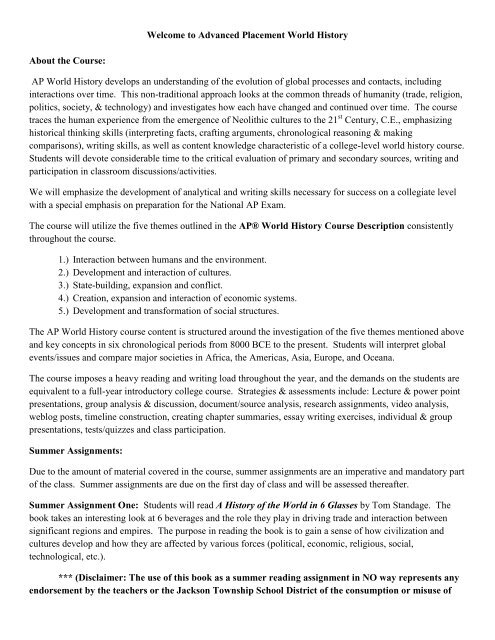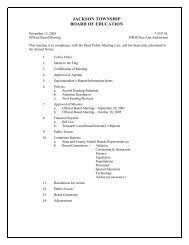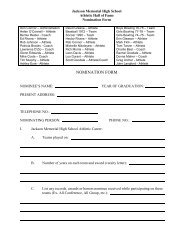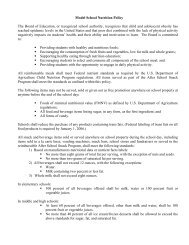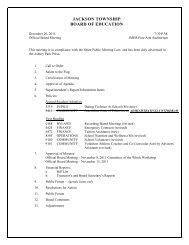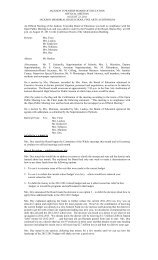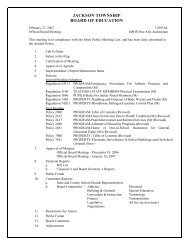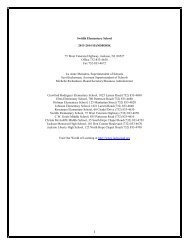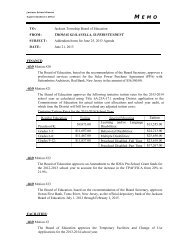AP World History Summer Assignment Letter - Jackson Liberty High ...
AP World History Summer Assignment Letter - Jackson Liberty High ...
AP World History Summer Assignment Letter - Jackson Liberty High ...
Create successful ePaper yourself
Turn your PDF publications into a flip-book with our unique Google optimized e-Paper software.
Welcome to Advanced Placement <strong>World</strong> <strong>History</strong><br />
About the Course:<br />
<strong>AP</strong> <strong>World</strong> <strong>History</strong> develops an understanding of the evolution of global processes and contacts, including<br />
interactions over time. This non-traditional approach looks at the common threads of humanity (trade, religion,<br />
politics, society, & technology) and investigates how each have changed and continued over time. The course<br />
traces the human experience from the emergence of Neolithic cultures to the 21 st Century, C.E., emphasizing<br />
historical thinking skills (interpreting facts, crafting arguments, chronological reasoning & making<br />
comparisons), writing skills, as well as content knowledge characteristic of a college-level world history course.<br />
Students will devote considerable time to the critical evaluation of primary and secondary sources, writing and<br />
participation in classroom discussions/activities.<br />
We will emphasize the development of analytical and writing skills necessary for success on a collegiate level<br />
with a special emphasis on preparation for the National <strong>AP</strong> Exam.<br />
The course will utilize the five themes outlined in the <strong>AP</strong>® <strong>World</strong> <strong>History</strong> Course Description consistently<br />
throughout the course.<br />
1.) Interaction between humans and the environment.<br />
2.) Development and interaction of cultures.<br />
3.) State-building, expansion and conflict.<br />
4.) Creation, expansion and interaction of economic systems.<br />
5.) Development and transformation of social structures.<br />
The <strong>AP</strong> <strong>World</strong> <strong>History</strong> course content is structured around the investigation of the five themes mentioned above<br />
and key concepts in six chronological periods from 8000 BCE to the present. Students will interpret global<br />
events/issues and compare major societies in Africa, the Americas, Asia, Europe, and Oceana.<br />
The course imposes a heavy reading and writing load throughout the year, and the demands on the students are<br />
equivalent to a full-year introductory college course. Strategies & assessments include: Lecture & power point<br />
presentations, group analysis & discussion, document/source analysis, research assignments, video analysis,<br />
weblog posts, timeline construction, creating chapter summaries, essay writing exercises, individual & group<br />
presentations, tests/quizzes and class participation.<br />
<strong>Summer</strong> <strong>Assignment</strong>s:<br />
Due to the amount of material covered in the course, summer assignments are an imperative and mandatory part<br />
of the class. <strong>Summer</strong> assignments are due on the first day of class and will be assessed thereafter.<br />
<strong>Summer</strong> <strong>Assignment</strong> One: Students will read A <strong>History</strong> of the <strong>World</strong> in 6 Glasses by Tom Standage. The<br />
book takes an interesting look at 6 beverages and the role they play in driving trade and interaction between<br />
significant regions and empires. The purpose in reading the book is to gain a sense of how civilization and<br />
cultures develop and how they are affected by various forces (political, economic, religious, social,<br />
technological, etc.).<br />
*** (Disclaimer: The use of this book as a summer reading assignment in NO way represents any<br />
endorsement by the teachers or the <strong>Jackson</strong> Township School District of the consumption or misuse of
these beverages! The book is simply meant to provide an interesting view of civilizations and trade, from<br />
which we can initiate our year-long discussions of world history.)<br />
<strong>Summer</strong> <strong>Assignment</strong> Two: Students will be required to read the first 6 chapters in the on-line text. Students<br />
will be provided Key Terms/People as well as a guided reading chart to aid them in organizing this information.<br />
Students will be given a password to access the on-line text in August. It is our suggestion that you complete<br />
the <strong>Summer</strong> Reading <strong>Assignment</strong> (<strong>Summer</strong> <strong>Assignment</strong> One) in July so you can spend all of August on<br />
<strong>Summer</strong> <strong>Assignment</strong> Two.<br />
***In order to receive your password to access the on-line text as well as other supplements parents are<br />
required to email John Pelano at <strong>Jackson</strong> Memorial <strong>High</strong> School jrpelano@jacksonsd.org or William<br />
Beaver at <strong>Jackson</strong> <strong>Liberty</strong> <strong>High</strong> School wrbeaver@jacksonsd.org ***<br />
This email will also serve as recognition by both parents and students of the summer assignment requirements<br />
as well as an understanding that <strong>AP</strong> <strong>World</strong> <strong>History</strong> is an academically rigorous and demanding college-level<br />
course which requires multiple hours of study per week.
<strong>AP</strong> WORLD HISTORY SUMMER ASSIGNMENT 2013-2014<br />
A summer reading assignment is the beginning of most Advanced Placement courses. This year`s summer<br />
reading assignment for <strong>AP</strong> <strong>World</strong> <strong>History</strong> is a <strong>History</strong> of the <strong>World</strong> in 6 Glasses by Tom Standage. This book<br />
traces the history of the world though a discussion of beverages that people drank in various time periods—<br />
beer, wine, spirits, coffee, tea and Coca-Cola. Reading the book will help you develop a perspective on our<br />
yearlong study of history of world civilization in <strong>AP</strong> <strong>World</strong> <strong>History</strong>.<br />
The assignments listed below are MANDATORY, are due on September 9, 2013, and are pledged assignments.<br />
Standage, Tom. A <strong>History</strong> of the <strong>World</strong> in 6 Glasses. 2006. ISBN-10 (for paperback edition): 9780802715524<br />
or ISBN-13: 978-0802715524.<br />
Directions:<br />
1. Read the book. It is a great book, and is read by a large number of <strong>AP</strong> <strong>World</strong> <strong>History</strong> students each year.<br />
2. INDEPENDENT WORK: Please note that the use of any resources on the internet regarding this book to<br />
complete your assignments will be viewed as plagiarism. In submitting your assignments, you are<br />
pledging that the work is the result of only your effort.<br />
3. A HISTORY OF THE WORLD IN SIX GLASSES GUIDED READING QUESTIONS: As you read,<br />
answer the attached reading questions for each chapter. Your answers need to be thorough, but do not<br />
need to be lengthy- 3 to 4 sentences should suffice for all but the summary questions where a longer<br />
request is specifically requested.<br />
4. ANNOTATED M<strong>AP</strong>S: You must create a collection of maps to illustrate the diffusion of three of the six<br />
beverages discussed in the book. Each beverage must be shown on a different map. (3 maps total)<br />
a. Maps should be presented on 8.5 x11 paper- one map per page.<br />
b. Use arrows to illustrate diffusion of the beverage (or its ingredients)- where did each beverage<br />
originate? To what places did it spread?<br />
c. Include at least 5 annotations on each map (i.e. - notes to explain significant events that<br />
happened in places labeled on the map). Include dates!<br />
d. Include a legend.<br />
e. Maps should be colorful. You may also include symbols or illustrations. Be creative!<br />
f. You may hand-draw your maps or create them digitally.<br />
g. Choose three of the six maps listed below. Your maps should be titled & labeled with the<br />
following:
Map #1: “Beer in Mesopotamia and Egypt”<br />
Label- Mesopotamia/ the Fertile Crescent, Egypt, Tigris River, Euphrates River, Nile River, Zagros Mts.,<br />
Anatolia, Mediterranean Sea, Red Sea, Persian Gulf, Arabian Desert, Sahara Desert<br />
Map #2: “Wine in Greece and Rome”<br />
Label- Greece, Crete, Athens, Sparta, Italy, Rome, Mediterranean Sea, Aegean Sea, Adriatic<br />
Sea, Sicily, Corsica, France/ Gaul, Spain, Tiber River, Egypt, Alexandria, Anatolia/Turkey, Germany<br />
Map #3: “Spirits in the Colonial Period”<br />
Label- Spain, Portugal, Great Britain, France, Netherlands, Germany, Atlantic Ocean, West Africa, Canary<br />
Islands, West Indies/Caribbean Islands, Brazil, Barbados, 13 colonies, Jamestown, Boston, Pennsylvania<br />
Map #4: “Coffee in the Age of Reason”<br />
Label- Ethiopia, Yemen, Arabian Desert, Mecca, Sahara Desert, Cairo, Great Britain, London, France,<br />
Paris, Netherlands, Suriname, Haiti, Cuba, Costa Rica, Venezuela, Brazil<br />
Map #5: “Tea and the British Empire”<br />
Label- China, Huang-He River, Yangtze River, Mongolia, Gobi Desert, Cairo, Tibet, Himalayan Mts.,<br />
India, Japan, Macao, South China Sea, Strait of Malacca, Dutch East Indies/ Indonesia, Netherlands, Great<br />
Britain, London, 13 colonies, Boston<br />
Map #6: “Coca-Cola and Rise of America”<br />
Label- United States, Atlanta, Washington D.C., New York, Japan, Europe, Germany,<br />
North Africa, the Soviet Union, the “Iron Curtain”- look this up!, Berlin, Israel, Egypt, Lebanon, Jordan,<br />
Saudi Arabia, Iraq, Kuwait, UAE<br />
5. TEXTBOOK QUESTIONS: Students will be required to read the first 6 chapters in the Traditions and<br />
Encounters on-line text. Students will be provided key terms/people as well as a guided reading chart to<br />
aid them in organizing this information. You can access these resources by going onto the <strong>Jackson</strong><br />
<strong>Liberty</strong>/Memorial website under school resources.<br />
6. M<strong>AP</strong> LABELING ASSIGNMENT: Use the map attached to identify specifically listed continents,<br />
bodies of water and important rivers.
Guided Reading Questions<br />
A <strong>History</strong> of the <strong>World</strong> in Six Glasses<br />
By Tom Standage<br />
Introduction<br />
1. What is the author`s main thesis (argument) in setting up his book? Why/how are these fluids “vital’?<br />
2. Why did water get replaced by other beverages in human settlements?<br />
“Beer in Mesopotamia and Egypt” (Chapters 1 and 2)<br />
1. What remarkable shift began happening about 12,000 years ago? Where did it happen?<br />
2. Describe the “ratchet effect” which caused farming to spread beyond the Fertile Crescent.<br />
3. How might beer have influenced the transition from hunting and gathering (Paleolithic) to agriculturalbased<br />
(Neolithic) societies?<br />
4. What does the story of beer tell you about social and gender roles in ancient SW Asia and Europe?<br />
5. How important do you think beer was in the growth and diffusion of the earliest civilizations? Would<br />
the earliest civilizations of SW Asia and Egypt have been as prosperous without the discovery of beer?<br />
6. What sources does the author use to gather his information on the use of beer and early civilizations?<br />
7. What is the relationship between early civilizations and writing? Civilizations and health?<br />
“Wine in Greece and Rome” (Chapters 3 and 4)<br />
1. Based on the story at the beginning of this chapter, DESCRIBE how rulers showed power and authority<br />
in early civilizations and empires. Then, ANALYZE why these methods were effective at that time.<br />
2. What does the story of wine tell you about social and gender roles in the Mediterranean world? How did<br />
this change over time?<br />
3. What effect does wine have on the development of Christianity and of Islam (separately)?<br />
4. How and why did wine evolve into a status symbol in Greece?<br />
5. What does the movement of wine show us about Rome and trading networks during this period of<br />
history?<br />
6. How was the complex social hierarchy of Rome revealed by wine?<br />
7. Describe and analyze the relationships between wine and empire, and wine and medicine and religion in<br />
Rome.<br />
“Spirits in the Colonial Period” (Chapters 5 and 6)<br />
1. In the 18 th century, how did spirits change the balance of power amongst the western European nations<br />
(particularly Britain and France)?<br />
2. Describe how spirits were first invented by Muslim scholars and then spread as a medicine to Europe.<br />
3. Describe and analyze the links between slavery, sugar, and alcohol. Then, explain how it was used by<br />
European explorers and naval forces.<br />
4. Why were spirits an important staple in Colonial America?<br />
5. How did rum play a role in the American Revolution?<br />
6. What is the connection between spirits and colonization?<br />
“Coffee in the Age of Reason” (Chapters 7 and 8)<br />
1. Was coffee the first true “global” beverage? Why or why not?<br />
2. How (and why) did coffee play a pivotal role in the Enlightenment and French Revolution?<br />
3. What different regions of the world were connected through the coffee trade? What role did each place<br />
have in trade?<br />
4. What important functions did coffee houses serve in the flow of information in the 1600s and 1700s?<br />
5. How did coffee and coffeehouses impact the following:<br />
a. Scientific thought<br />
b. Business<br />
c. Political thought
“Tea and the British Empire” (Chapters 9 and 10)<br />
1. Why was tea important to China`s economy, and how did it affect China`s relationships with other<br />
countries?<br />
2. Explain the relationship between tea and the Industrial Revolution.<br />
3. Compare and contrast how the British trade in tea affected America and India.<br />
4. Why was the British Empire called “this vast empire on which the sun never sets?”<br />
5. How did tea reach England? How did it spread from the very top of society to the drink enjoyed by coalcarters<br />
and common working people?<br />
6. How did Britain become a drug-dealing nation, in order to retain and grow their access to tea?<br />
7. How do the actions of Britain against China during this period show the impact of the Industrial<br />
Revolution on power relationships in the globe?<br />
“Coca-Cola and the Rise of America” (Chapters 11 and 12)<br />
1. How does the story of Coca-Cola relate to the rise of capitalism and entrepreneurship in the 19 th and<br />
early 20 th century? How does this story show a larger global economic shift?<br />
2. How does Coca-Cola affect people`s views of the United States? Is the spread of Coca-Cola an example<br />
of “Americanization” around the world?<br />
3. How did Coca-Cola successfully market its product? EXPLAIN how this example shows the<br />
development of “consumer culture.”<br />
4. ANALYZE how these developments exhibit the idea of globalization.<br />
Epilogue- “Back to the Source”<br />
1. Do you agree or disagree with Standage`s argument in the epilogue? Will water be the most influential<br />
beverage in shaping the global situation of the next 100+ years? Why or why not?<br />
2. Define “Developed <strong>World</strong>” and “Developing <strong>World</strong>.”<br />
3. What differences can you see in these two “<strong>World</strong>s” based on their issues with this beverage?


